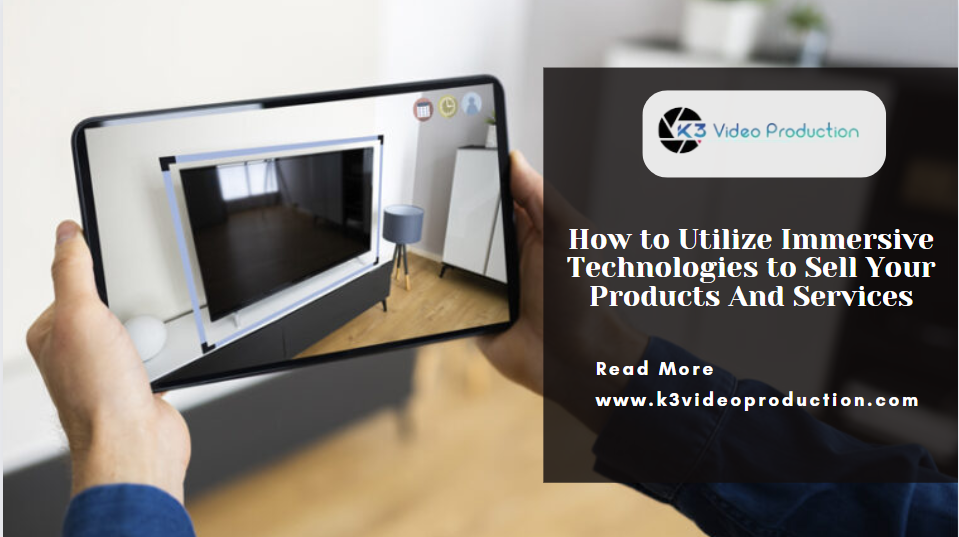How to Utilize Immersive Technologies to Sell Your Products And Services
Table of Contents
ToggleOver the past few years, the way people buy and sell products – commerce in general, has undergone a drastic evolution, especially since the pandemic. With brick-and-mortar shops being closed in conformance with social distancing and lockdown, brands developed improved and rich ways for customers to shop from the comfort of their homes, which inadvertently led to the boom of eCommerce.
Today, companies are battling to offer the best most enriching shopping experiences for customers online. While a major share of people no longer prefers going to stores and shopping in person, they still wish to enjoy the advantages that come with it, such as seeing, touching, and examining products up close.
This is where immersive technologies like Augmented Reality and Virtual Reality (AR/VR) shine.
By incorporating these innovative capabilities into your shopping channels, you can provide an engaging and immersive online shopping experience for customers, almost as good as visiting a store.
Here we discuss some solid ways to do so. Partnering with an experienced Chicago video production company can immensely help you incorporate some of these techniques into your sales and marketing avenues.
Before we get into that, here is a brief about what AR/VR entails and what some other immersive technologies are.
What are the most Popular Immersive Technologies Today?
AR and VR are undoubtedly two of the most popular and widely used immersive technologies today. In addition to that, the phenomenon of Mixed Reality is also fast gaining popularity.
Augmented Reality
AR is essentially an innovative overlay of digital content onto the physical world. In other words, the technology helps enhance the real world by overlaying digital objects through pictures, videos, and 3D objects, onto the real environment. It inevitably uses devices that feature a camera, such as smartphones, headsets, or smart glasses. It makes use of capabilities like computer vision, sensory input, and depth tracking to blend the physical and digital worlds together, and allows customers to experience the product in a physical environment they choose.
Virtual Reality
Virtual Reality allows the user to completely transform a physical space into another world through a dedicated VR device. It uses features like 360-degree vision and computer-generated imagery to simulate an entirely different and unique experience for the user while staying in the comfort of their real-world space. In effect, it lets the user interact and engage with the elements of the created world, generating a superior sense of presence and richness that transcends traditional media.
Mixed Reality
Mixed Reality is a comprehensive piece of technology that combines the features of AR and VR to offer a seamless blend of the physical and digital worlds. It allows users to immerse in digital world experiences while also being able to interact with elements in the physical world. It uses capabilities like spatial mapping and sensors to achieve this and provides a more deeply engaging experience.
The best and most experienced Chicago product photography and video production companies make use of these technologies to offer high-level collateral to help brands improve sales.
Now here are some great ways to incorporate these innovations into your selling channels.
Allow Customers to see what a Product Looks like in their Room/Space
One of the primary uses of immersive technologies these days is to provide the customer with a virtual experience of what the product looks like in their personal space, which may be a room, a home, or an office. It is most useful for brands that sell electronic appliances or home goods and furniture, such as sofas, chairs, tables, televisions, home theatre systems, washing machines, etc.
For example, a furniture brand can enable an AR-infused shopping experience on their eCommerce website through which a customer can place the sofa in his or her living room and see what it looks like, what its approximate dimensions are, what its color and texture are, etc. This essentially gives them as good an experience as touching and feeling the sofa in person, while also letting them see if it is a good fit for their home.
A well-equipped Chicago video production company can help you incorporate it into your shopping channels.
Allow Users to try on Clothing
Clothing brands can utilize AR/VR technologies to let customers try on their pieces without visiting the store. This is the best example of how customers can experience the benefits of shopping in person from a brick-and-mortar store, while also enjoying being in the comfort of their homes. This allows them to try on various styles, check the sizing, and see if the outfit looks good on them. Many eyewear brands and retail shopping giants already use these technologies to offer an engaging experience. Some of them also provide customizable avatars, which customers can alter to look exactly like them, simulating a very real fitting experience.
Allow Users to Try on Beauty Products
Beauty products, such as foundations and lipsticks are things that need careful analysis before purchase. Customers undoubtedly need a means to check the shade against their skin tone or complexion to find the perfect match. Brands can effectively utilize AR to offer this service.
Sephora already uses AR-infused trials on their eCommerce website. It allows customers to choose shades of foundations, concealers, lipsticks, blushes, etc. more accurately, as opposed to guessing what works based on the provided swatch pictures. Tech-savvy Chicago product photography companies can provide full-blown swatches to be used in conjunction with AR technologies to let customers try them on virtually.
Provide Personalized Brand Experiences
An innovative and delightful way to offer immersive experiences to customers is to offer personalized experiences with branding elements like packaging.
For example, Jack Daniels, the wildly famous Tennessee Whiskey, created an exceptionally engaging AR experience with the label on their bottle. Users were required to download the JD application and point the smartphone at the bottle’s label, which would open an immersive range of experiences, including a virtual tour of their distillery. This allows a near-perfect simulation of an in-person visit to their distillery all the way in Lynchburg.
This way, you can offer highly creative experiences for customers using AR and VR, and impress customers, ultimately contributing to better relationships.
Brands using AR/VR Capabilities
Here are some well-known brands that have successfully incorporated AR/VR-infused channels for sales. These are pioneer brands having been some of the first few to utilize the technologies to improve sales.
Amazon AR – Room Decorator
The Amazon AR app allows users to add furniture and décor items to their rooms virtually. It even enables the addition of multiple products at the same time, to let users design or remodel their space entirely. You can also save the layouts within the app to refer later.
Dulux Visualization App
Dulux the international paint manufacturer offers a visualization app for customers through which the homeowner can simply point the smart device to their walls and see how a shade of paint actually looks on their home walls.
Burberry
Burberry has an AR-enabled 3D visualization app, created in collaboration with Google. It allows users who search for their products to view their 3D renditions on their screens. It was earlier accessible only for the Burberry app users, however, later, they partnered with Google to improve reach.
Adidas
Adidas has an app that provides Virtual Try Ons (VTO) for their shoes, which was initially only for iOS users, and later enabled for Android users as well. It allowed users to get a first-hand experience of how the shoes looked in real life on their feet.
The brand has also utilized AR-infused experiences several times at in-person events, including a 2021 campaign in several locations in Europe, and a gamified mobile AR experience for shoppers at their Flagship store in Paris.
Gucci Try on App
Gucci was the first ever luxury fashion brand to integrate AR into their marketing campaigns. Their app allowed users to try out their shoes, and see how they looked on their feet. Many other brands followed suit once the initiative turned out to be immensely successful.
Wrapping up
AR, VR, and MR have undoubtedly changed the way people shop online. From offering real-life try-on experiences to letting customers visualize products at different locations, the possibilities and opportunities that these technologies have opened for brands are diverse. The benefits on the other hand are multi-fold. By providing rich shopping experiences for people, AR/VR-infused capabilities have allowed brands to build solid customer relationships, while strengthening existing ones.
To seamlessly integrate these technologies, you inevitably need the help of a commercial photographer Chicago. And this is where we come in. Contact our team to create delightful purchase and shopping experiences for your customers with Augmented and Virtual Reality.








